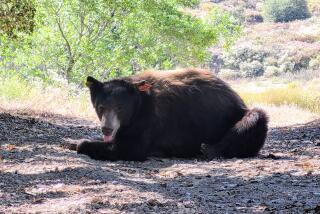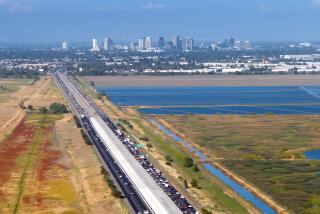Traffic Reporter Sees Beauty and the Beast From the Air
- Share via
From Rudy Grande’s vantage, the afternoon commute doesn’t look all that bad. It’s actually kind of pretty: a shimmering string of brake lights winking red along the Ventura Freeway through Sherman Oaks as a fiery sun sinks below the horizon.
Yet what is beautiful from a helicopter at 1,000 feet is, at street level, nothing more than another clutch-mangling, teeth-gnashing nightmare.
As an airborne radio traffic reporter, Grande spots the bottlenecks and bumper-thumpers on Southern California freeways and helps drivers steer clear of them. Thousands of commuters--from San Bernardino rock ‘n’ rollers to Westside National Public Radio types--depend on Grande’s daily observations from on high to get them home in time for dinner--or at least in time for, well, bed.
Especially in post-quake Los Angeles, where damaged freeways have turned commuting into a crapshoot, Grande and others like him act as eyes in the sky to warn drivers of trouble ahead and spy alternate routes.
“It’s different every day,” says Grande, who broadcasts live reports from the air an average of every two or three minutes during the morning and afternoon commutes. He works for Metro Traffic Control Inc., the largest traffic-reporting service in Southern California. “It’s a fun gig.”
*
The flight takes off at 4 p.m. sharp from Van Nuys Airport. As pilot Al Davis checks the gauges in his preflight routine, Grande dashes across the Tarmac, hops into the back seat of the Bell JetRanger and slams the door.
Seconds later, Davis lifts the aircraft off the ground and points it north toward the beleaguered Newhall Pass. As Davis chats with the airport tower, Grande slips on his headphones and adjusts the radio equipment at his feet.
In his lap rests a clipboard to jot down problem areas. Notes at the top of the page remind Grande which of the seven radio stations to which he reports is carrying his broadcast at any given time. Over the next two hours, he constantly monitors the stations, listening for his cues and changing his style from straight man to funny man.
Broadcasting for oldies station KRTH 101.1-FM, he remarks on the sunset, made bloody red by a shroud of smog. But for public radio station KCRW 89.9-FM, his reporting is spare and tight. The same goes for his spots on news station KNX 1070-AM, which run every six minutes.
In the front seat next to Davis, another Metro Traffic reporter, Jorge Jarrin, files dispatches in the same frantic pace for talk station KABC 790-AM and a handful of Spanish-language stations.
With his laminated Thomas Bros. map spread across his lap, Grande, a former disc jockey from Albuquerque, N. M., peers down at the Santa Monica Freeway and looks for less congested surface streets. He suggests Washington Boulevard on his next report.
It is a tricky business. Traffic is fluid and it changes from minute to minute. But monitoring all freeways is impossible, so Grande and other airborne reporters swap information over their radios. For instance, a reporter over the San Bernardino Freeway reports a tie-up, which Grande includes in one of his dispatches--even though he is over the Long Beach Freeway at the time.
“Notice,” he says, “I didn’t say I saw it. But somebody did.”
*
Back on the ground, Grande talks about the service he and other traffic reporters provide for commuters. “Maybe by listening to my report, someone will make it home a little less likely to kick the dog,” he says.
But a USC professor thinks that the way Grande and others present their information reinforces aggressive driving attitudes.
“The atmosphere is like being in one of those carnivals with bumper cars,” said Sandra Ball-Rokeach, a communications professor at the Annenberg School.
Ball-Rokeach does not argue that traffic reports make people drive like maniacs. But she does believe that humanizing the reports could make motorists more careful as they drive.
“Identification mechanisms--such as a person’s age and sex--often are not there,” she said. “The reports often send out the message that cars get hurt--not people. Think of the reports that describe a crash as ‘five cars off to the side’ or a ‘jackknifed truck.’ But you don’t hear about what’s happened to the passengers in the car or to the truck driver.”
She wants radio and television traffic reporters to make their dispatches more sensitive and refer to values such as responsibility, health, politeness and self-control. This could be done, she said, without making reports wordy or boring or preachy.
“They can do it in a very efficient and entertaining way,” she said, explaining that it may take several years for her ideas to catch on. “It has to be a community effort.”
All that’s fine for a classroom, Grande said. But from his vantage point at the top of the world, the bottom line is telling freeway drivers how to get from here to there with the least amount of hassle.
“I try to identify with the guy on the street,” says Grande, who, like everyone else, hates traffic jams. “What I would want to hear is what I’m going to say.”
*
Dear Street Smart:
I am part of a group that discusses urban folklore and legends, and a variety of rumors and puzzling questions about traffic laws pop up in our discussions from time to time. I’m hoping you can settle one of the more frequent points of debate within our group.
Many people claim that if a police car, fire engine, ambulance and mail truck all pulled up to a four-way intersection at the same time, the mail truck would have the right of way over the other three vehicles. Reasons for this answer range from the mail truck’s being a federal vehicle to the possibility that the mail truck could be carrying a declaration of war. Could you please explain whether the mail truck would have the right of way, and if so, why?
David Mikkelson, San Fernando Valley Folklore Society, Canoga Park
Dear Reader:
Yours sounds like an exciting group. And although it took some doing, we at Street Smart found the answer to your query. However, it may only provide more fuel for your debates.
In short, the mail truck does not have the right of way. Like other vehicles and even pedestrians, it must pull to the side of the road to let the emergency vehicles pass. After that, it gets a little more complicated. Our answer comes from Bill Madison, a spokesman for the California Department of Motor Vehicles.
Everyone else we queried thought the question was unique, to say the least.
“That’s about the craziest thing I’ve ever heard,” said an officer with the Los Angeles Police Department’s Valley Traffic Division. “I don’t even know how people have time to think about stuff like that.”
Undaunted, we pressed on.
“OK,” a California Highway Patrol officer said in a tone that suggested he didn’t take the question seriously.
Finally, Madison responded. “The mail truck is not even in the running, unless the guy is a complete idiot,” he said.
It is unlikely, in fact, that the President and the Congress would post a declaration of war through the regular mail. (“Hillary, do you have a stamp?”) Even a U. S. Postal Service spokeswoman said diplomatic couriers are the more likely route.
But once the mail truck is safely to the side of the road, the question becomes trickier. Madison speculated that dispatchers would solve the situation before it arose. If they did not, he said it would make sense for the police car to go first and then the firetruck. The ambulance would go last, he said, because if “five seconds makes a difference, you probably aren’t going to save the guy anyway.”
*
Dear Street Smart:
What constitutes a speed trap, and are they legal? From time to time on the northern down slope of Barham Boulevard, heading toward Burbank, an officer with a radar speed detector is stationed to catch those going over the 35-m.p.h. speed limit. Insofar as almost everybody (except me, of course) goes at least 45 m.p.h. after leaving the Lake Hollywood intersection at the top, it’s rather like shooting fish in a barrel.
And in view of the wide boulevard and the long stretches without side roads, such a speed is not, in my opinion, dangerous. In spite of the fact that I use Barham a number of times each week and am aware of the possibility of the radar trap, I find it difficult to remember that it might be there and inadvertently go with the flow, but fortunately I have not forgotten and have not fallen afoul of the radar. Yet.
Edward P. Ancona, Hollywood
Dear Reader:
To answer the second part of your question first, speed traps are not legal. But the situation you describe along Barham Boulevard is not a speed trap.
Most of us probably think of speed traps as some small-town cop hiding on his motorcycle behind a Dairy Queen sign waiting for interstate travelers to zip by at Daytona speeds.
But according to CHP Officer Tito Gomez, the vehicle code defines a speed trap as a section of highway that is measured so patrol officers can calculate a driver’s speed by timing how long it takes to travel between Point A and Point B--such as between two over-crossings.
In such cases, the officers never really drive alongside the speeder. This is illegal. They are supposed to either calculate the speed by literally following the speeder or by using radar.
A speed trap can also mean an officer is using radar on a stretch of road on which a speed limit is posted but has not recently been reviewed by traffic engineers.
Think of a road that was last determined to have a speed limit of 25 m.p.h. 10 years ago. In the meantime, the road has been widened or improved in some way to make faster travel safe. But the speed limit stays 25. If an officer nails a driver with radar on that street for driving faster than 25 m.p.h., it can be considered a speed trap.
LAPD Officer Tom Souza said that all city streets on which radar is used are surveyed regularly. Even then, he said, the officer probably won’t ticket a driver for driving just a little fast. Souza said surveys are done to determine a street’s safe speed, and that may be a few miles over the posted limit.
More to Read
Sign up for Essential California
The most important California stories and recommendations in your inbox every morning.
You may occasionally receive promotional content from the Los Angeles Times.









